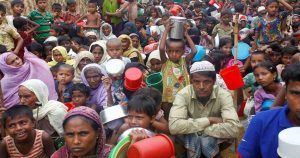UNHCR, the UN refugee agency, on Thursday said the relocation of Rohingyas to Bhasanchar Island in Noakhali would not be realistic right now as they first want to see what the facilities are available there.
“So, my own impression would be, since we talk now, I don’t really think it’ll be realistic that the Island will be a solution,” UNHCR’s Assistant High Commissioner for Operations George Okoth-Obbo told reporters at a press conference here mentioning that rains have already arrived.
He said as far as they know the Island is not ready yet and they are very interested to know the answers to a number of questions, including what will be the facilities there, what are the communication facilities and other services. “We’re interested to know full range of things.”
Okoth-Obbo said they have agreed with the government that a visit will be arranged for UNHCR and others to see what are the facilities that are being put in place before they start shifting people.
The government says some 1 lakh Rohingya people, now living in Cox’s Bazar district, will be shifted to Bhasanchar soon for giving them shelter there until their repatriation.
Bangladesh is a disaster-prone country and the upcoming monsoon may cause untold sufferings to the Rohingyas, the government source says.
Okoth-Obbo laid emphasis on safe relocation of Rohingyas to avert deaths due to monsoon. “We remain extremely concerned though there has been considerable work that has been done.”
He said the relocation of 200,000 Rohingyas to a safer place is the key to saving their lives and it will have to be done as soon as possible.
The UNHCR senior official shared about difficulties in making the allocated land useable for Rohingya shelters.
Okoth-Obbo made it clear that conditions are not yet safe and secure for the sustainable return of Rohingyas to Myanmar though Myanmar has sent a small list of verified citizens for repatriation.
“Right at the moment, we don’t believe conditions have been created for safe return…(favourable) conditions don’t exist,” he said adding that refugees are still arriving.
Earlier, Okoth-Obbo visited Rohingya camps to review UNHCR’s work on the ground, assess emergency response and monsoon preparations.
The Assistant High Commissioner visited the main Kutupalong refugee site in Ukhia sub-district and reviewed UNHCR’s work there.
It is estimated that 200,000 Rohingya could be at danger of landslides and or flooding, and UNHCR and its partners have been working to try to mitigate the risks inside the settlements, as well as relocating families who would potentially lose their homes due to landslides to safer areas, said UNHCR.
Okoth-Obbo also visited Camp 4 extension where additional land was recently allocated by the Bangladesh government to help relocate families most at risk of landslides when the monsoon hits.
Extensive work to prepare the hilly land was part of a joint initiative by UNHCR, IOM and WFP under the interagency Site Management Engineering Project (SMEP).
UNHCR and partners are currently installing shelters and services on an initial 12 acres of newly-prepared land that could provide homes for nearly 500 families.
Okoth-Obbo visited other refugee settlements in Nayapara and Chakmarkul before he returns to Dhaka for the final commitments of his mission.
He arrived here on Sunday on a five-day visit to see the agency’s ongoing response to the Rohingya refugee emergency and preparations ahead of the monsoon season.
Okoth-Obbo began his five-day visit meeting key Bangladesh government officials who are involved in the Rohingya response.
He expressed his gratitude to the government and the people of Bangladesh for hosting close to 880,000 refugees and reiterated UNHCR’s commitment to continue support and work closely with the government on all aspects, particularly to avert harm due to the monsoon.




